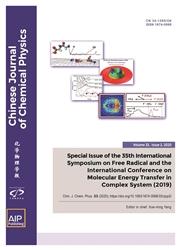Excited-state double proton transfer of 1,8-dihydroxy-2-naphthaldehyde: A MS-CASPT2//CASSCF study
IF 1.2
4区 化学
Q4 PHYSICS, ATOMIC, MOLECULAR & CHEMICAL
引用次数: 2
Abstract
Excited-state double proton transfer (ESDPT) is a controversial issue which has long been plagued with theoretical and experimental communities. Herein, we took 1,8-dihydroxy-2-naphthaldehyde (DHNA) as a prototype and used combined complete active space self-consistent field (CASSCF) and multi-state complete active-space second-order perturbation (MS-CASPT2) methods to investigate ES-DPT and excited-state deactivation pathways of DHNA. Three different tautomer minima of S1-ENOL, S1-KETO-1, and S1-KETO-2 and two crucial conical intersections of S1S0-KETO-1 and S1S0-KETO-2 in.and between the S0 and S1 states were obtained. S1-KETO-1 and S1-KETO-2 should take responsibility for experimentally observing dual-emission bands. In addition, two-dimensional potential energy surfaces (2D-PESs) and linear interpolated internal coordinate paths connecting relevant structures were calculated at the MS-CASPT2//CASSCF level and confirmed a stepwise ESDPT mechanism. Specifically, the first proton transfer from S1-ENOL to S1-KETO-1 is barrierless, whereas the second one from S1-KETO-1 to S1-KETO-2 demands a barrier of ca. 6.0 kcal/mol. The linear interpolated internal coordinate path connecting S1-KETO-1 (S1-KETO-2) and S1S0-KETO-1 (S1S0-KETO-2) is uphill with a barrier of ca. 12.0 kcal/mol, which will trap DHNA in the S1 state while therefore enabling dual-emission bands. On the other hand, the S1/S0 conical intersections would also prompt the S1 system to decay to the S0 state, which could be to certain extent suppressed by locking the rotation of the C5−C8−C9−O10 dihedral angle. These mechanistic insights are not only helpful for understanding ESDPT but also useful for designing novel molecular materials with excellent photoluminescent performances.1,8-二羟基-2-萘醛激发态双质子转移:MS-CASPT2//CASSCF研究
激发态双质子转移(ESDPT)是一个长期困扰理论界和实验界的争议性问题。本文以1,8-二羟基-2-萘醛(hna)为原型,采用联合完全活性空间自一致场(CASSCF)和多态完全活性空间二阶摄动(MS-CASPT2)方法研究了hna的ES-DPT和激发态失活途径。S1-ENOL、S1-KETO-1和S1-KETO-2的三个不同的互变异构体极小值和S1S0-KETO-1和S1S0-KETO-2的两个关键的锥形交叉点。在S0和S1态之间。S1-KETO-1和S1-KETO-2应负责双发射波段的实验观测。此外,在MS-CASPT2//CASSCF水平上计算二维势能面(2D-PESs)和连接相关结构的线性插值内坐标路径,确认了ESDPT的阶梯式机制。具体来说,质子从S1-ENOL到S1-KETO-1的第一次转移是无势垒的,而从S1-KETO-1到S1-KETO-2的第二次转移需要约6.0 kcal/mol的势垒。连接S1- keto -1 (S1- keto -2)和S1S0-KETO-1 (S1S0-KETO-2)的线性内插值坐标路径是上坡的,势垒约为12.0 kcal/mol,这将使dna处于S1态,从而实现双发射带。另一方面,S1/S0的锥形交点也会促使S1体系衰变为S0态,锁定C5−C8−C9−O10二面角的旋转可以在一定程度上抑制S1体系的衰变。这些机理的发现不仅有助于理解ESDPT,而且有助于设计具有优异光致发光性能的新型分子材料。
本文章由计算机程序翻译,如有差异,请以英文原文为准。
求助全文
约1分钟内获得全文
求助全文
来源期刊

Chinese Journal of Chemical Physics
物理-物理:原子、分子和化学物理
CiteScore
1.90
自引率
10.00%
发文量
2763
审稿时长
3 months
期刊介绍:
Chinese Journal of Chemical Physics (CJCP) aims to bridge atomic and molecular level research in broad scope for disciplines in chemistry, physics, material science and life sciences, including the following:
Theoretical Methods, Algorithms, Statistical and Quantum Chemistry
Gas Phase Dynamics and Structure: Spectroscopy, Molecular Interactions, Scattering, Photochemistry
Condensed Phase Dynamics, Structure, and Thermodynamics: Spectroscopy, Reactions, and Relaxation Processes
Surfaces, Interfaces, Single Molecules, Materials and Nanosciences
Polymers, Biopolymers, and Complex Systems
Other related topics
 求助内容:
求助内容: 应助结果提醒方式:
应助结果提醒方式:


